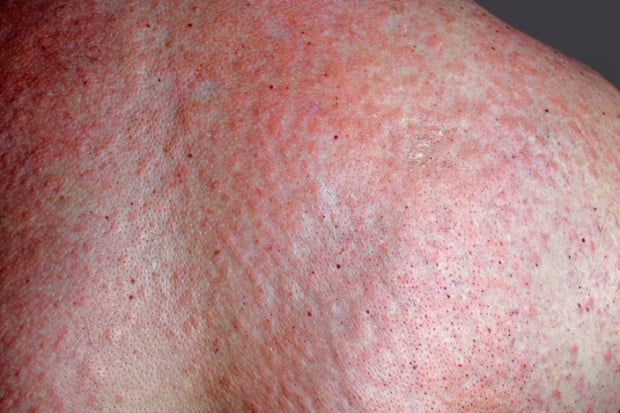Many autistic children are struggling to cope in schools and are being removed, a charity warns.
Daily Archives: 16/11/2017
Bryozoans: Fossil fills missing evolutionary link
[unable to retrieve full-text content]

Unlocking the secrets of Ebola
[unable to retrieve full-text content]

Hot spots of tick-borne diseases in Mongolia
[unable to retrieve full-text content]

Boots ‘breaking’ morning-after pill promise, say Labour MPs
MPs urge the pharmacy to complete its roll-out of cheaper contraception across all of its stores.
Health24.com | Think you have an allergy? It could be something completely different
Millions of people worldwide are affected by allergies. In simple terms, when we’re allergic to something, our immune system mistakenly believes that the substance is harmful to our body and launches an attack.
Some allergies, like hay fever, can be seasonal, which means that they only occur during certain times of the year.
Allergies are caused by:
- Things you touch (contact allergy – e.g. latex)
- Things you inhale (inhaled allergy – e.g. pollen)
- Things you eat (ingested allergy – e.g. shellfish)
Allergies can be deadly
In many cases an allergy is just a nuisance, causing reactions like runny or congested noses (inhaled), hives (contact) or digestive (ingested) issues.
Allergies should, however, be taken seriously as in extreme cases an allergic reaction can cause anaphylactic shock and even death.
You’ve probably had an unpleasant reaction to something you’ve came into contact with and wondered if you have an allergy. Fortunately true allergies are relatively rare, and according to a study published in The Journal of Allergy and Clinical Immunology less than 4% of the American population have a true allergic reaction to one or more foods.
Good ways of testing for allergies are the skin test and blood test. The blood test measures the levels of IgE antibodies in your body after eating certain foods, while in the skin test microscopic amounts of common allergens are placed under the first layer of skin, and if you’re allergic to something, you’ll see a mosquito bite-like bump within 15 to 30 minutes.
Allergy, sensitivity or intolerance?
People often think they’re allergic to something when it’s actually only a sensitivity or intolerance. As mentioned above, an allergy involves the immune system, whereas in the case of a food sensitivity or intolerance the reaction is mainly in the digestive system.
1. Ingested allergy
According to Prevention, the following are signs that the reaction you’re suffering after consuming certain foods is not an allergy:
Your symptoms are all in your stomach. Sensitivities and intolerances result mostly in GI complaints like diarrhoea, constipation, gas or bloating. A true food allergy will, however, result in symptoms like hives, swelling, difficulty breathing, wheezing, sneezing and trouble swallowing.
It’s mainly in your head. A headache after eating doesn’t indicate an allergy. Headaches and brain fog indicate a sensitivity. The same applies to behaviour changes like hyperactivity. A true allergic reaction is more likely to make one clingy (especially in children), withdrawn and quieter than usual.
Symptoms come on gradually. If you’re sensitive or intolerant to something you ate, it might take a few hours for you to feel really bad. Allergic reactions, however, happen quickly and peak around 30 minutes after exposure.
You don’t feel the same every time you eat the same food. When you have an intolerance or a sensitivity, you might not experience symptoms every time you eat that food. With food allergies, the reaction happens every time.
You can handle a bit of the food or prepare it a safer way. Sometimes a little bit might be fine. People tend to be able to handle small amounts of foods they’re sensitive to. In the case of an allergy, even a crumb can be enough to cause a reaction.
2. Inhaled allergy
It’s often difficult to tell the difference between respiratory ailments like colds and seasonal allergies like hay fever. Colds are largely caused by viruses, whereas inhaled allergies like hay fever are usually caused by airborne pollens.
The following differences can help you to tell seasonal allergies and colds apart:
Consider the time of year. Colds mainly occur in the winter, while seasonal allergies tend to appear in spring. If symptoms occur at the same time each year, it’s likely to be an allergy rather than a cold. If symptoms appear immediately after exposure to pollens it’s probably an allergy as colds take a few days to develop after exposure to a virus.
Duration of symptoms. A cold will usually last three to 14 days, but allergy symptoms last for as long as the person is exposed to pollen.
Colour of nasal discharge. Colds tend to produce green or yellow mucus, while seasonal allergies usually produce clear nasal secretions.
Fever and muscle aches. Seasonal allergies don’t usually cause fever or body aches, whereas people with a cold often have these symptoms.
3. Contact allergy
There are many skin conditions that can cause itchiness and rashes, but only some of them are allergy-related.
Various dermatologic conditions affecting the skin can cause itchiness and rashes, but only some are caused by an allergy. Insect bites, autoimmune conditions, fungal, bacterial and viral infections for instance can all cause a rash to appear.
The most common allergic skin rashes are:
Atopic dermatitis (eczema). Atopic dermatitis or eczema frequently occurs in young children. There is a red rash with small blisters or bumps that might flake and ooze. Atopic dermatitis is linked to food allergies.
Urticaria (hives). Urticaria or hives is an itchy rash that appears as raised red bumps of various shapes and sizes. It typically lasts for only minutes to hours. It can be very itchy. Chronic urticaria can, however, last for weeks.
Contact dermatitis (urticaria). Contact dermatitis is caused by direct skin contact with a substance a person is allergic to, causing a rash-like reaction. Examples are cosmetics, metals, topical medications and plants like poison ivy. Urticaria can be acute (lasting less than six weeks) or chronic (lasting more than six weeks).
Image credit: iStock

Health24.com | How a sheep’s ability to recognise Brad Pitt can help save lives
If you ever find yourself in the company of sheep, don’t be surprised if they seem to recognise you.
Researchers trained eight sheep to identify celebrity faces from photographs. The investigators also found that the sheep could identify a picture of their handler without any training.
This line of research could help improve understanding of Huntington’s disease and other neurodegenerative conditions in people, according to scientists at the University of Cambridge in England.
Help for Huntington’s disease
Along with dogs and monkeys, sheep are social animals that can recognise other sheep as well as familiar people, the study authors explained. However, the ability of sheep to identify faces was unclear.
“Anyone who has spent time working with sheep will know that they are intelligent, individual animals who are able to recognise their handlers,” said study leader Jenny Morton.
“We’ve shown with our study that sheep have advanced face-recognition abilities, comparable with those of humans and monkeys,” she noted in a university news release.
“Sheep are long-lived and have brains that are similar in size and complexity to those of some monkeys. That means they can be useful models to help us understand disorders of the brain – such as Huntington’s disease – that develop over a long time and affect [mental] abilities,” Morton said.
What is Huntington’s disease?
Huntington’s disease is a genetic disorder that causes neurons (nerve cells) in particular parts of the brain to degenerate, resulting in debilitating physical, cognitive and emotional problems.
This disease is caused by a mutation in a single gene (IT15). The child of a person carrying this gene (male or female) has a 50% chance of inheriting it if they receive the gene. It is not exactly sure how nerve cells are killed off. Symptoms differ from person to person and can be physiological (twitching, loss of balance), cognitive (thinking, judgement, memory) or psychological (a change in personality).

How the study will help
This study was published in the journal Royal Society: Open Science.
“Our study gives us another way to monitor how these abilities change, particularly in sheep who carry the gene mutation that causes Huntington’s disease,” Morton pointed out.
Huntington’s disease gets progressively worse, and features uncontrolled movements, abnormal posture, and changes in behaviour, judgment and thinking.
Morton and her team are currently studying sheep that have been genetically modified to carry the gene mutation that causes Huntington’s disease.
Image credit: iStock
NEXT ON HEALTH24X

Health24.com | How to fuel for really long rides
If you’ve ever wondered why 44-year-old endurance star Rebecca Rusch is often called the “queen of pain”, just look at her record.
She is a three-time winner and current record-holder of the Leadville 100 (a tough 160km high altitude MTB race in America), 2011 singlespeed champion, three-time 24 Hour Solo world champion and competitor in legendary endurance events like the Eco Challenge and Primal Quest.
But as Rusch explains it, success in gruelling events involves more than enduring pain and training hard – a lot depends on learning how to fuel your body like the performance machine that it is.
“You don’t have to be obsessive about it or have a PhD,” she says, “but you do need to approach your fuelling with intention.”
Whether you’re racing Leadville, or heading out on an all-day ride, here’s her advice on how to eat and drink right.
Read more: Why you shouldn’t feel bad about fuelling rides with chocolate
Know the basics
Rusch’s numbers are easy to remember: 500 to 700ml ounces of fluid per hour, and approximately 837 kilojoules per hour.
These are estimates that will vary depending on how hot it is (read: how much you sweat) and how much you weigh, but if you consume much more than that, you’re going to overload your system.
Beyond that? “Race fuelling starts 10 minutes before the gun goes off and continues at very regular intervals for the duration,” Rusch says. If you’re an hour in before you eat or drink, you’re going to be playing catch-up the entire event.
Adjust as necessary
“It’s not just about straight calories and hydration,” Rusch says. “During training, you should start with the calories you’ll need, then read labels and try different things to find what works. By the time race day rolls around, you should have a system dialled.”
Read more: Is your water hydrating you?
Don’t forget electrolytes
Sodium, potassium, calcium and other electrolytes help the body absorb fluids and assist with a number of other important functions, like muscle function. Include a source of electrolytes, either from a sports drink or supplement, in your race nutrition plan.
“Someone once explained it to me like this,” Rusch says. “Your calories are like the gas in the car. The electrolytes are like the oil. You need both for the car to run efficiently.”
Do your homework
Rusch uses the off-season to hone her nutrition plan, and she takes the job seriously. One example: She recently started using a different product for her primary race fuel.
It wasn’t a change she made on a whim – she sought input from her coach, the director of athletic performance at Red Bull, sports scientist Allen Lim and others.
Then, Rusch used the products for months during off-season training before making the switch. Bottom line: It pays to research your food choices well in advance.
Read more: Eat carbs, ride fast: why this pro cyclist bakes his own bread
Don’t eat too much
Conventional wisdom says you should eat three hours before a race to allow for proper digestion. If that’s not an option, then eat a light meal.
Eat a heavy breakfast too close to the event and “the extra food will just sit in your gut”, Rusch says.
If you’ve eaten well in the weeks leading up to the event, your glycogen stores are already topped off – just follow your in-race fuelling strategy and you’ll be good to go.
Save protein for later
Protein can be hard to digest during events and lead to a bloated feeling that can make you miserable. If your energy gel, bar or drink has added protein, consider switching to something without, or something with added amino acids, which Rusch says actually can help improve performance.
Save the protein-rich recovery drinks for right after the race or workout.
“You have a short window immediately following those intense efforts where your body is really receptive to the added benefits of a recovery drink,” Rusch says.
Read more: 4 delicious and simple homemade protein bars
This article was originally featured on www.bicycling.co.za
Image credit: iStock
NEXT ON HEALTH24X

First gene-editing in human body attempt
Gene-editing has been attempted on cells inside a patient, in a world first by doctors in California.
Dying mother’s bid to raise funds to keep her children out of care
Sam Kyme has motor neurone disease and wants her two sons to live with her sister in Australia.







